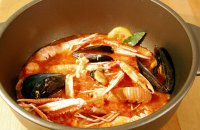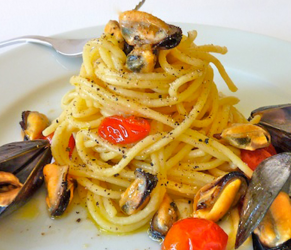In Sweets
From ancient times through until the present day, Greeks have enjoyed the intoxicating combination of nuts and honey, especially walnuts and honey. As indicated in excavated records, a sweet similar to today’s peanut brittle, but made instead with walnuts, was particularly popular with the ancients. Today, as the Greek repertoire of nut-based sweets continues to expand, that combination is still overwhelmingly popular.
The best-known nut-based pastry is, without a doubt, the baklava. You will find this sweet in myriad variations-prepared with almonds, with walnuts, with pistachios, even with pine nuts, or with complicated combinations of nuts. Baklava is generally prepared in whole sheet pans. The distinguishing regional feature, besides the variety of nuts used, is the height of the pastry- a feature determined by the number of phyllo layers and the quantity of nuts used in the filling.
Nevertheless, there are some baklava prepared in individual pieces and either baked or fried. While some of these versions call for the traditional honey-based syrups, others, such as one found in the Macedonian town of Naoussa, call for a dense, dark syrup made from boiled down grape must (known in Greek as “petimezi”).
Desserts similar to baklava, that is, phyllo desserts that call for nuts, include a whole range of shapes, from cylindrical finger-sized logs filled with nuts to little coils in which the center is speckled with nuts. Often times these individual nut-filled pastries have humorous names. In Tinos, for example, one can enjoy the “psarakia,” a pastry whose name translates roughly to little fish. This pastry is a handmade Christmas specialty filled with ground walnuts and shaped into small cylinders. The edges are pressed together with the tines of a fork, and, once fried, they do somewhat resemble small fried fish.
In sweets, nuts are not limited to the realm of phyllo leaves. One of the best-loved winter sweets is the deliciously spiced “karydopita,” or walnut cake, a rich cake in which ground nuts are used almost as flour, mixed in to lend texture and density to the recipe. This dough is then baked, before being soaked in a light syrup. Nuts form the basis of some of Greece’s best cookies, too, especially the crisp, “kourambiedes,” a kind of shortbread cookie made from blanched, ground almonds; and the “melomakarona,” a cookie often either topped with ground walnuts or filled with them, then dipped in honey syrup. Both of these desserts are classics on the Greek Christmas table. Another interesting nut-based cookie, “moustatsonia,” comes from the island of Corfu and is made with ground almonds, eggs, sugar and vanilla. Unlike the more common “kourambiedes,” these cookies are not dusted with powdered sugar but simply enjoyed as is. Furthermore, different types of nuts, most prominently ground walnuts, find their way onto the crisp, fried dough fritters known as “thiples.”
Walnuts also characterize another of Greece’s widespread sweets- the kataifi, a kind of nut roll made with shredded wheat pastry and doused with honey syrup. Similarly, walnuts appear in at least two unusual sweet pastries from the island of Tinos: one is filled with sweet potatoes and walnuts, while the other with rice, walnuts, and chard, a variety of beet.
Other unusual nut-based sweets involve preserved nuts and fall under the category of spoon sweets. Such recipes call for young, immature nuts, still encased in their downy green shells, that will be preserved in a sugar syrup, and spiced with cloves or cinnamon. As a specialty of Aegina, an island internationally renown for its pistachios, the pistachio spoon sweet is perhaps the most common. Conversely, the walnut spoon sweet, due to its increasing uncommonness, is the most revered throughout Greece. This spoon sweet requires that the walnuts be soaked for around forty days, until they become completely black. Once preserved in the syrup, they become an absolutely intoxicating dessert.
My personal favorite is the “amygdalota,” the sugar-dusted white confections found all over the Greek islands. These macaroon-like cookies are generally made with blanched, ground almonds, sugar, egg whites and either rose water, orange blossom water or liqueur. They are often shaped into tiny lets or pears or balls, and usually baked.
In Savory Dishes
In addition to their prominence in desserts, nuts are also employed in a variety of other dishes. They are often used as thickeners and bases in sauces and dip-like dishes. Almonds, for example, appear in regional preparations of “taramosalata,” the Greek fish-roe spread, lending a creamy, mild texture. While using potatoes or dried bread as a base often results in an unappetizing stickiness or gumminess, almonds will allow for the perfect consistency. Recipes for “skordalia,” the well-known garlic spread, will also call for almonds, but walnuts are generally more preferred.
Similarly, walnuts, pine nuts, chestnuts, and almonds all find their way into a plethora of stuffings. Walnuts, when combined with tomatoes and onions, appear in one of the country’s most unique savory pies, a recipe from Naoussa. The nuts give weight and texture to the dish, and, once baked, the filling resembles ground meat so closely that it is nearly impossible to differentiate the two. The "ground meat" substitute makes appearances in other dishes as well, such as the omelet filled with ground walnut, that can be found in Chios, an island in the eastern Aegean. Likewise, Christmas turkey is traditionally filled with a lovely chestnut and rice stuffing, as are several Easter preparations from the Aegean islands. A whole array of rice-stuffed dishes utilize nuts, from the classic pine-nut-and-rice-stuffed grape leaves, to all manner of vegetables stuffed with rice and nuts.
Ironically, despite the wide use of nuts throughout the Greek kitchen, there isn’t a specific word in Greek to denote "nuts." To a Greek cook, nuts fall under the general category of "xyroi karpoi," or dried fruits, which can include anything from sesame seeds to almonds to dried apricots, a rather nutty definition of a much-loved and ages old ingredient.
The Omnipotence of Nuts
The use of nuts within Greek cooking is overwhelmingly prevalent, with nuts making their appearance constantly in sweets and desserts, while customarily in other savory dishes as well.
Tips
Observational studies and clinical trials at Harvard University have suggested that nut consumption has beneficial effects on coronary heart disease and its intermediate biomarkers such as blood cholesterol. Increased nut consumption has been associated with a reduced risk of major chronic diseases, including cardiovascular disease and type 2 diabetes mellitus. See the results of the study in a video.
Country:
Category:
Related Articles
Most Popular recipes



































































